There was magic in the air after Mary Martin said, “I’d like to sing some Disney songs,” and Walt Disney said, “I can’t think of anyone I would rather hear sing them.”

HI-HO – MARY MARTIN
Mary Sings and Mary Swings Walt Disney Favorites
With Tutti Camarata, His Trumpets and Orchestra
Disneyland Records WDL-3038 (Mono) STER-3038 (Stereo)(12” 33 1/3 RPM)
1959 LP Reissue (Same Cover): WDL-4016 (Mono) STER-4016 (Stereo) 1959
CD Reissues:
• Walt Disney Records Japan
• 2015 Walt Disney Records Wonderland Music Store, Disneyland & Walt Disney World (2015)
• 2016 Stage Door Records (unofficial release)
• Currently on iTunes and amazon
MARY MARTIN SINGS WALT DISNEY FAVORITES (1966 Reissue of Hi-Ho)
Disneyland Records Storyteller Series (12” 33 1/3 RPM with Book) ST-3943
(Mono) STER-3943 (Stereo) August 1966
Originally Released in March 1958. Executive Producer/Liner Notes: Jimmy Johnson. Producer: Camarata. Conductor: John Lesko. Running Time: 31 minutes.
Films and Songs:
Snow White and the Seven Dwarfs: “Hi-Ho,” “One Song,” “Whistle While You Work,” “I’m Wishing,” “With a Smile and A Song,” “Some Day My Prince Will Come” by Larry Morey, Frank Churchill.
So Dear to My Heart: “Lavender Blue (Dilly Dilly)” by Elliot Daniel, Larry Morey.
Bambi: “I Bring You a Song” by Larry Morey, Frank Churchill.
Cinderella: “The Magic Song (Bibbidi-Bobbidi-Boo)” by Al Hoffman, Jerry Livingston, Mack David.
Pinocchio: “When You Wish Upon a Star” by Ned Washington, Leigh Harline.
Alice in Wonderland: “I’m Late” by Bob Hilliard, Sammy Fain.
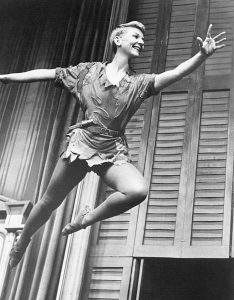 Mary Martin was the first superstar to perform on records produced, marketed and distributed by the Walt Disney Studios. Disney had no in-house record company before the spring of 1956, so every established star connected with Disney-related recordings was heard on Columbia, Decca, RCA and various other labels.
Mary Martin was the first superstar to perform on records produced, marketed and distributed by the Walt Disney Studios. Disney had no in-house record company before the spring of 1956, so every established star connected with Disney-related recordings was heard on Columbia, Decca, RCA and various other labels.
Few stars today have the impact that Mary Martin had at the time. She became the toast of Broadway in 1938 when she brought down the house with Cole Porter’s “My Heart Belongs to Daddy” in Leave It to Me and reached legendary status in 1949 with the landmark musical, Rodgers and Hammerstein’s South Pacific.
Her energetic personality was ideal for the stage and was a magnetic presence in early TV households. In 1954, only sixteen days after the limited Broadway engagement of Peter Pan the sets and cast moved to the NBC TV studios intact, making the small screen version a virtual duplicate of what audiences saw on stage. It caused a sensation, attracting the largest viewership up to that time.
This is a promo for NBC’s 1955 broadcast, which was also done live (this was before videotape).
One more live performance of Peter Pan was staged on NBC in 1956. Between Pan and Mary Martin’s many other television appearances in this era, the release of the Hi-Ho album in 1958 was a major achievement on behalf of the fledgling Disneyland label. The coup of signing her was one of the many benefits of having Tutti Camarata as the creative force upon which the entire Disney Group owes its foundation.
In addition to his eclectic skills as a musician, arranger and conductor for countless types of music, Camarata was one of those people who seemed to “know everyone.” One of his colleagues recalled that it was not uncommon for one of these friends to drop by a session to say hello, followed by Camarata introducing them: “This is Mantovani,” or “Say hello to Bing Crosby.”
Back in the mid-forties, when Mary Martin was trying to transition from stage to movies, her succession of setbacks earned her the nickname of “Audition Mary.” But a triumphant live performance at Ciro’s nightclub in Hollywood made industry insiders take notice. In her autobiography, Martin recounted a pivotal moment that occurred when she did a piece of music first in operatic style, then as a swing number.
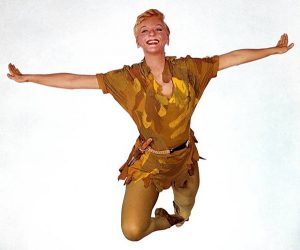 Tutti Camarata created the pop music tempo change for the Jimmy Dorsey Orchestra, in which Bob Eberle would sing a ballad, the orchestra would kick into a swing and Helen O’Connell would pick it up and bring it to a snappy close. (He would do the same for Disney on “’Twas Brillig,” a song from The Greatest Record Ever Made.) Though Martin does not state it specifically in her book, it is verifiable that she and Camarata worked together during that period when she and he were at Decca Records—and they remained lifelong friends. [Even decades later, when Martin was making a comeback of sorts, Camarata was in his office at Sunset Sound in Hollywood, working on arrangements for her musical performance while Prince was recording in Studio C.]
Tutti Camarata created the pop music tempo change for the Jimmy Dorsey Orchestra, in which Bob Eberle would sing a ballad, the orchestra would kick into a swing and Helen O’Connell would pick it up and bring it to a snappy close. (He would do the same for Disney on “’Twas Brillig,” a song from The Greatest Record Ever Made.) Though Martin does not state it specifically in her book, it is verifiable that she and Camarata worked together during that period when she and he were at Decca Records—and they remained lifelong friends. [Even decades later, when Martin was making a comeback of sorts, Camarata was in his office at Sunset Sound in Hollywood, working on arrangements for her musical performance while Prince was recording in Studio C.]
Hi-Ho employs the talents of Martin and Camarata and Martin to full advantage. Camarata in his intricate, often idiosyncratic arrangements and Martin for her singing and acting range. It’s essentially an album for adult listening—particularly the torrid “I Bring You a Song” and the sultry “Bibbidi-Bobbidi-Boo,” but always in the context of listening as a family. It’s also worth noting that almost every song includes verses not usually heard in connection with the songs, even the ones so often performed and recorded. It’s great fun to play guessing games to see if folks can figure out what familiar Disney favorite begins with such lyrics as “If your mind is in a dither and your heart is in a haze…”
In 1959, shortly after the stereo Hi-Ho LP was issued, NBC presented the 1960 videotaped production of Peter Pan, (this would be the version repeated throughout the sixties, revived in the eighties on NBC, released on home video and presented on the Disney Channel.)
Collectors may want to note that two songs have slight differences on the mono and stereo versions of Hi-Ho, though the vocal tracks are identical. The ending of “Whistle While You Work” has a slightly different ending. And the backing track of the title tune sounds as if it has either been completely rerecorded or is an alternate. When “Tutti’s Trumpets” make their signature progressive descent after the first chorus, it sounds more rushed in the mono version, along with other minute differences. Perhaps Camarata chose to use another take or made an entirely new instrumental track in 1959, just as he did with the title song to Alice in Wonderland when he remade it in stereo and included it on Walt Disney’s Music Cavalcade, which we explored in this Animation Spin.
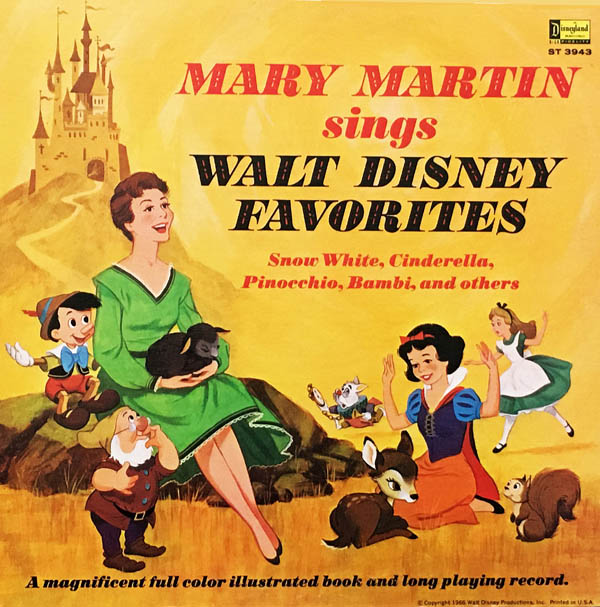
In 1966, Peter Pan was rebroadcast on NBC and Hi-Ho was reissued as Mary Martin Sings Walt Disney Favorites. It was completely revamped as a Disneyland Storyteller book and record set. The order of the songs was changed, perhaps to make it more kid-friendly. All the Snow White songs are placed on side one, with the more sedate “I’m Wishing” opening the album instead of the boisterous big band “Hi-Ho.”
The biggest change is in the picture book. It features a Disney-illustrated version of Mary Martin herself (and as our own Jerry Beck noticed, wearing a smart Peter Pan-green dress), featured within the context of classic Disney animated films. This may be the only time, at least in print, that this was done with a celebrity. Martin might take an observational role (watching Alice follow the White Rabbit); take in the animated settings (reclining on Snow White’s wishing well, the Dwarfs’ mine car or Granny Kincaid’s fence); or taking a more active role (making Doc’s bed, greeting Jiminy Cricket and a newly-living Pinocchio, feeding a squirrel in Bambi’s forest and getting the first seat in Cinderella’s pumpkin coach).
Collectors note: the mono version of this album does not differ from the stereo as the earlier releases do, but contains the same tracks originating from the stereo selections.

The results were such that Camarata and Johnson must have taken great pride in the Hi-Ho album. Every opportunity was taken to include selections on singles and compilations. It was, naturally, good for business–Martin was very much a “name” to adult record buyers at the time–but the recordings spoke for themselves.
Hi-Ho is actually the second Disneyland Records release featuring Mary Martin and Camarata. A two-disc 45 RPM set called The Little Lame Lamb, based on a story by Disney artists that appeared in Family Circle magazine, was released a few months earlier for Christmas 1957.
“Hi-Ho”
Decades of experience in arranging for big bands, intimate knowledge of the trumpet and skill in the matching of artist to orchestra meets the razor-sharp dynamic range and kinetic energy of a powerful entertainer. What comes true most, though, are two sincere friends who want to do well for each other on a project they truly believe in.
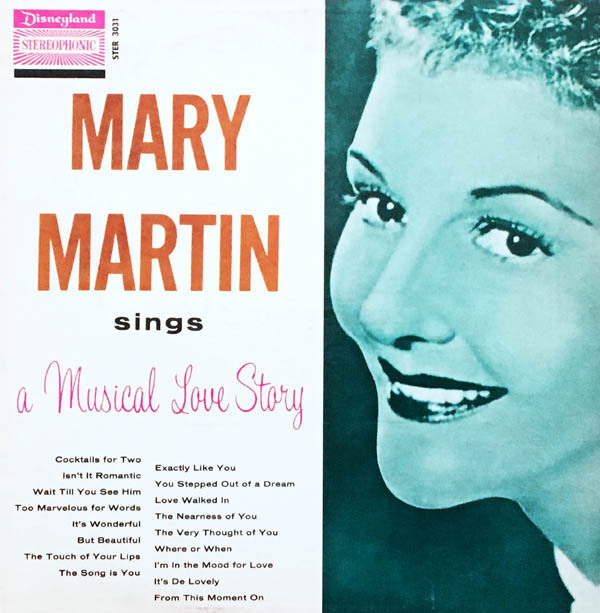
MARY MARTIN SINGS A MUSICAL LOVE STORY
Disneyland Records WDL-3031 (Mono) STER-3031 (Stereo) (12” 33 1/3 RPM)
Released in October 1958. Executive Producer/Liner Notes: Jimmy Johnson. Producer: Richard Halliday. Arranger/Conductor; Camarata. Running Time: 27 minutes.
Songs: “Cocktails for Two” by Sam Coslow, Arthur Johnston; Isn’t It Romantic?” “Wait Till You See Him,” “Where or When” by Richard Rodgers, Lorenz Hart; “S’ Wonderful,” “Love Walked In” by George and Ira Gershwin; “The Touch of Your Lips,” “The Very Thought of You” by Ray Noble; “Exactly Like You,” “I’m in the Mood for Love” by Jimmy McHugh, Dorothy Fields; “It’s De-Lovely,” “From This Moment On” by Cole Porter; “Too Marvelous for Words” by Johnny Mercer, Richard Whiting; “But Beautiful” by Johnny Burke, Jimmy Van Heusen; “The Song is You” by Jerome Kern, Oscar Hammerstein II; “You Stepped Out of a Dream” by Nacio Herb Brown, Gus Kahn; “The Nearness of You” by Ned Washington, Hoagy Carmichael.
A sophisticated recording designed for the high fidelity/stereophonic home entertainment boom, this album would be just the thing to play at parties or intimate evenings back in the days of cars that looked like big toasters.
What makes it especially unique is the format. Martin sings seventeen romantic ballads in two continuous medleys that take up one full band on each side of the album, one tune blending into the other. With the piano and small combo, the effect is that of an elegant supper club, or a night at the home of Rob and Laura Petrie when Alan Brady comes over and wants to be really impressed. (“Ohhhhh, Rob! Do you think you can still get Mary Martin to sing at our party after Buddy and Sally dropped all those walnuts on her husband?”)
The stereo version of the album is given an interesting intimacy by keeping Martin’s voice in the left channel while the musicians are heard playing on the center and right. The conductor of the album, John Lesko, worked on arrangements and orchestrations with Camarata three years prior on a historic installment of Ford Star Jubilee called Together With Music, which starred Martin in a dual concert with another legend, Noel Coward.
Years later, cassettes of this album were donated by Lillian Disney for an event called “An Evening with Mary Martin and Friends” to benefit the Palm Springs Desert Museum.
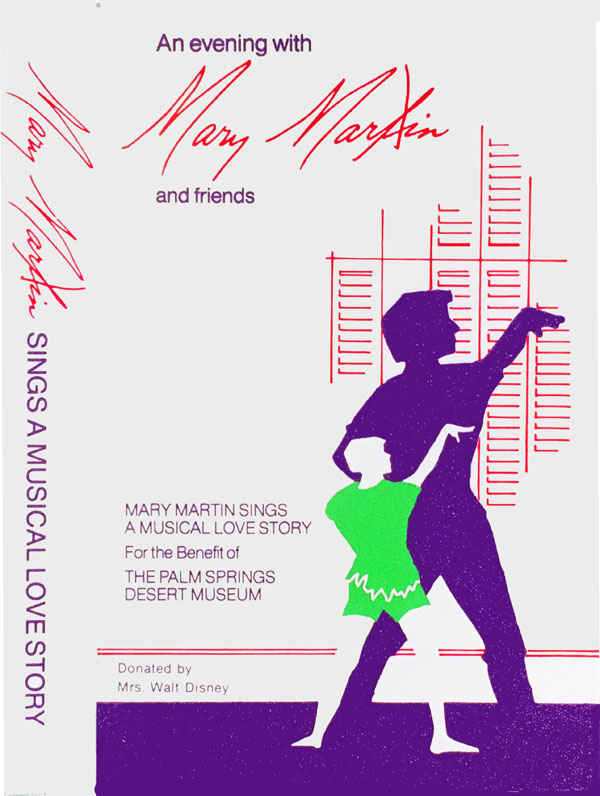
“Cocktails for Two”
Mary Martin’s version is as romantic and true to the original composition as it should be, but to many fans of Spike Jones and His City Slickers, this tune inspired one of the most hilarious comedy hits of all time.
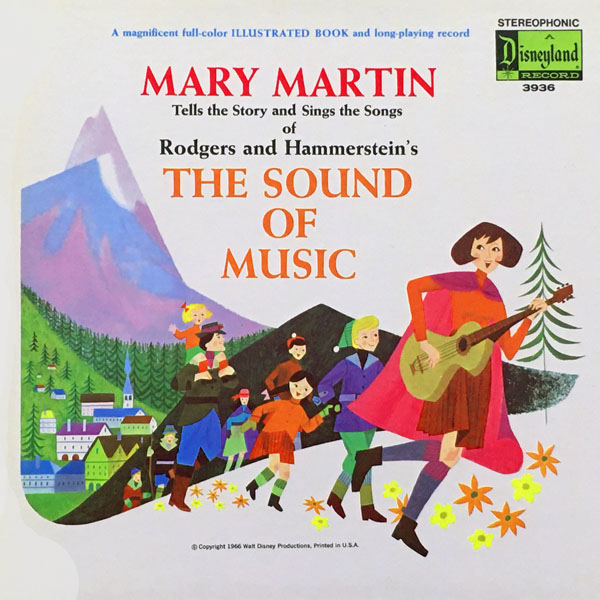
MARY MARTIN
Tells The Story and Sings The Songs of THE SOUND OF MUSIC
Disneyland Records Storyteller Series ST-3936 (Mono) STER-3936 (Stereo) (12” 33 1/3 RPM with Book)
Originally Released in April 1966. Executive Producer/Liner Notes/Story Adaptation: Jimmy Johnson. Adapted from the Film Screenplay by Ernest Lehman and the Stage Book by Howard Lindsay, Russel Crouse, Producer: Camarata. Conductor: John Lesko. Running Time: 31 minutes.
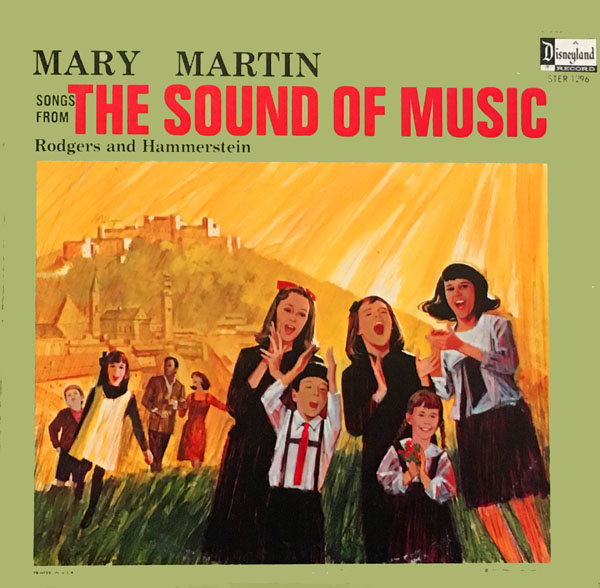
MARY MARTIN
Songs from THE SOUND OF MUSIC
Disneyland Records (12” 33 1/3 RPM with Book) DQ-1296 (Mono) STER-1296 (Stereo)
Originally Released in July 1966. Executive Producer/Liner Notes: Jimmy Johnson. Producer: Camarata. Musical Direction: Robert Lowe. Additional Vocalists: Roger Dann, Barbara Brown. Running Time: 18 minutes.
Songs: “The Sound of Music,” A Bell is No Bell,” “My Favorite Things,” “Do-Re-Mi,” “The Lonely Goatherd,” “So Long, Farewell,” “Edelweiss” by Richard Rodgers, Oscar Hammerstein II.
When the movie version of The Sound of Music was Hollywood’s biggest hit of the mid-sixties, only RCA could boast the soundtrack with Julie Andrews and only Columbia had the 1959 cast album with Mary Martin (for whom the show was written).
But Disney had Tutti Camarata, who knew Mary Martin and could have a very special set of albums recorded. In late 1965, after the movie version of The Sound of Music premiered, Martin was opening in London’s West End production of Hello Dolly! at the Theatre Royal, Drury Lane. Meanwhile, at London’s Palace Theatre, The Sound of Music stage show had been running strong since 1961 (a thirteen-year-old Andrew Lloyd Webber attended the premiere after writing Richard Rodgers a fan letter).
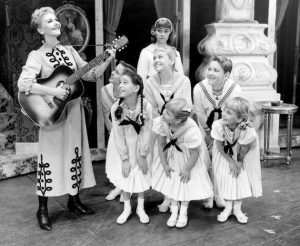
Martin and the original Broadway cast of “The Sound of Music”. Shown from left: (top) Mary Martin, Joseph Stewart, Kathy Dunn, William Snowden, Lauri Peters; (front) Marilyn Rogers, Evanna Lien, Mary Susan Locke
Since The Sound of Music was already performing in London, Camarata was able to have musical director Robert Lowe conduct using the same West End arrangements (the 1961 cast album reveals this to be the case). The album notes credit “The Robert Lowe Orchestra” but does not mention who sings for the Captain or the children, but there is no reason to assume that it is anyone other than Roger Dann, Barbara Brown and the other cast members from the London show.
For the Storyteller, Jimmy Johnson chose to have Mary Martin tell the story from the Julie Andrews/20tth Century Fox film rather than the Broadway version, a decision that made sense since almost everyone listening to the album by 1966 would expect the songs and story to occur the way they saw it on the big screen.
The song album runs almost half as long as the story version and does not contain the short instrumental excerpts of “Climb Every Mountain” and the “Leander” heard on the Storyteller. One wonders if “Climb Every Mountain,” sounding obviously like a music bed, was intended as another solo for Martin that never came to be. Maybe it will be unearthed someday. Never say never, I always say…
Mary Martin’s Disney legacy does not stop even with these recordings, as longtime readers of Animation Spin might recall. She also told the story and sang the songs on the Sleeping Beauty Storyteller album, which we discussed here.
“A Bell is No Bell”
Oscar Hammerstein II was one of the first people to recognize the potential talent in a young, struggling Mary Martin. She was a lifelong friend of Hammerstein and his wife Dorothy and many of his lyrics held special meaning. This song is actually a verse from the reprise of “Sixteen Going on Seventeen,” sung by Maria to Liesl in the second act (but not included in the film). Camarata isolated the verse and undoubtedly arranged it for the album himself as it is not part of other Sound of Music albums and has distinct Camarata flourishes.



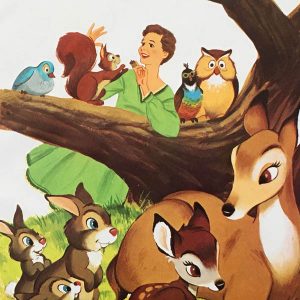
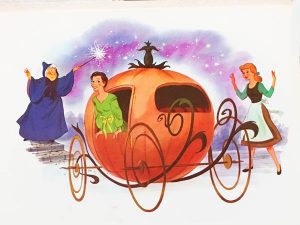
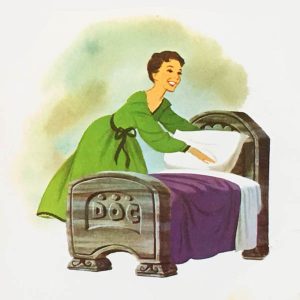
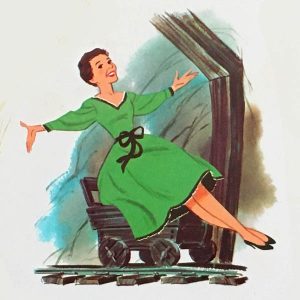
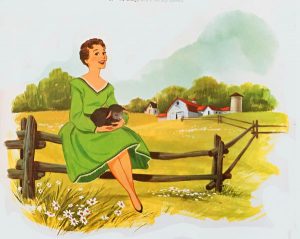

 GREG EHRBAR is a freelance writer/producer for television, advertising, books, theme parks and stage. Greg has worked on content for such studios as Disney, Warner and Universal, with some of Hollywood’s biggest stars. His numerous books include Mouse Tracks: The Story of Walt Disney Records (with Tim Hollis). Visit
GREG EHRBAR is a freelance writer/producer for television, advertising, books, theme parks and stage. Greg has worked on content for such studios as Disney, Warner and Universal, with some of Hollywood’s biggest stars. His numerous books include Mouse Tracks: The Story of Walt Disney Records (with Tim Hollis). Visit 





















































Of special note is Martin’s rendition of “I Bring You a Song” from Bambi on the “Hi-Ho” album. Just try singing along with it and you will discover vocal properties that Mary Martin had which few singers do. She sings the song in a very low register which would be a strain for many female vocalists to achieve, and yet it sounds effortless and at the same time is very haunting. This is a song rarely “covered” by vocal artists paying tribute to Disney music.
The original cover, to me, does not do justice either to the performer or to Disney. I much prefer the later version with the drawn image of Miss Martin among the settings and characters of the Disney films.
New to me on this post: I did not realize or had forgotten that she recorded a narrative of the Sound of Music story. That is something I would love to hear if you can ever include it in a future post.
Alas, in the “old days” when I was a child, I remember seeing most of these albums in record stores, but I did not know who Mary Martin was and so they did not have the special significance that they have for me now, as I of course have since come to appreciate her amazing vocal talents. Her name recognition slipped in the years following her peak popularity, because by the time I was in college and made a passing reference to her in an essay, nobody in my class had ever heard of her. It’s a shame, because she gave the world an amazing legacy. (To say nothing about giving us Major Anthony Nelson and J. R. Ewing.)
Mary Martin’s rendition of “I’m Late” was the final track on a Disneyland compilation album my sister had when we were little. The cover showed all the Disney characters riding a merry-go-round. Except for the scat-singing duet with King Louie and Baloo the bear, “I’m Late” was my favourite track on the album, and it may have helped spawn my fondness for up-tempo songs with rapid-fire lyrics — Gilbert & Sullivan patter arias, that sort of thing. Imagine my disappointment when I later saw the movie and found that not only did the White Rabbit sing a grossly attenuated version of the song, but ‘HE’ sounded like Droopy!
So in that lovely illustration from the Storyteller record, it looks to me as though Alice is chasing the rabbit away so that Mary can sing the song instead!
That made me wonder: What other famous singers might Disney have incorporated into the illustrations of its subsequent story albums? All I could imagine was a storybook version of Tarzan featuring Phil Collins — and as soon as I did, I couldn’t stop laughing.
Mary Martin could really SWING! I’m surprised to hear her sing in this style, because my parents had the “Sound Of Music” original cast album, and they played it a lot. So I always thought that she was kind of tight-laced and stuffy, like the music from that play and the later film.
I was wrong about that, and thank you for your very detailed historical article, Mr. Ehrbar.
Mary did at least two other projects for the label – a storyteller version of Sleeping Beauty (ST-3911), and an original Christmas story, “The Little Lame Lamb”, originally issued as a double EP-45 set with pictures (STEP-1002), then as a rather short LP (ST-2002). “Sleeping Beauty” is on YouTube complete – “Lamb” is not. I’ve heard portions of both, and frankly, Mary’s narration is a bit stiff and – dare I say it – sometimes overacted. Is this why you chose not to mention either of these in the article? Perhaps storytelling wasn’t Mary’s forte.. .
Both were mentioned in the article. Though I have not covered The Little Lame Lamb in detail, there was a post about the Sleeping Beauty Storyteller some time ago.
https://cartoonresearch.com/index.php/waking-sleeping-beauty-records/
It amuses me that Mary Martin worked so hard at cultivating such a wholesome image for herself in her later career, when her breakthrough moment was the Cole Porter song, “My Heart Belongs To Daddy” for the 1938 musical “Leave It To Me”. She performed a striptease on stage as she sang about being a “kept woman” in that show. In 1949 Mary Martin was the original Nellie Forbush in “South Pacific” on Broadway New York, and sang “I’ve Gotta Wash That Man Right Out of My Hair”, as she took a shower, mostly unclothed, onstage. By the time she got all Disneyed up, I guess Mary hoped that all those stage productions had been forgotten.
Properly spelled “Heigh-Ho!”
I’m sure they knew that — Camarata produced the Snow White soundtrack album. I don’t know why it was spelled that way, except maybe it was to make it stand out as a jazz pop rendition, since it is so very diffrerent than the Heigh-Ho most people knew at the time.
There seems to be a bit of wonderful overdubbing on the MONO version of Hi Ho that I don’t find in the stereo version. It is on the I’m WIshing number where Mary’s voice echoes her own voice in a delightful arrangement. I notice that that the stereo version isn’t available on iTunes as this overdubbing doesn’t seem to exist. Perhaps I’m wrong, but it would be so nice to hear her ultiple voices again!
You are absolutely correct, Stephen! I listened to all the albums again for this article (a pleasure) but I did not notice that–maybe because Camarata’s arrangement took center stage in the stereo version–but still, excellent catch. The vocal arrangement with the callbacks are similar to the Darlene Gillespies with Gloria Wood on the Walt Disney Song Fest album. Like the other stereo remixes, the stereo version of “I’m Wishing” was used, even in mono, on the 1996 Storyteller reissue and the only way to hear the callbacks is to have the mono version.
I wonder why Disneyland Records didn’t have Mary Martin record any songs from the Disney version of “Peter Pan.”
My presumption is because she already had her own successful musical vefrsion of PETER PAN from television, with which she did not wish to compete. Understanable, but it would have been great to hear her sing “You Can Fly! You Can Fly! You Can Fly”, “The Second Star to the Right” and “Never Smile at a Crocodile” in her very unique style.
Glorious article, Greg, with wonderful snippets from these albums. Now I want to hear EVERYTHING!